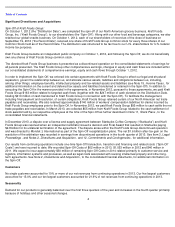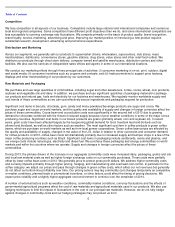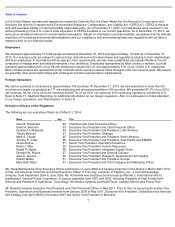Mondelez 2013 Annual Report Download - page 18
Download and view the complete annual report
Please find page 18 of the 2013 Mondelez annual report below. You can navigate through the pages in the report by either clicking on the pages listed below, or by using the keyword search tool below to find specific information within the annual report.
Table of Contents
With respect to acquisitions and joint ventures in particular, we are also exposed to potential risks based on our ability to conform
standards, controls, policies and procedures, and business cultures; consolidate and streamline operations and infrastructures;
identify and eliminate redundant and underperforming operations and assets; manage inefficiencies associated with the integration
of operations; and coordinate antitrust and competition laws in the U.S., the European Union and other jurisdictions. Joint ventures
and strategic alliances pose additional risks, as ownership and management responsibilities are shared with one or more other
parties who may not have the same objectives, priorities, strategies or resources as we do. Furthermore, we may not be able to
complete, on terms favorable to us, desired or proposed divestitures of businesses that do not meet our strategic objectives or our
growth or profitability targets. Our divestiture activities may require us to recognize impairment charges or to take action to reduce
costs that remain after a divestiture is completed. Gains or losses on the sales of, or lost operating income from, those businesses
may also affect our profitability.
Any of these risks and challenges could materially and adversely affect our business, product sales, financial condition and results
of operations.
Failure to maintain effective internal control over financial reporting could adversely affect our reputation, results of
operations and stock price.
The accuracy of our financial reporting depends on the effectiveness of our internal control over financial reporting. Internal control
over financial reporting can provide only reasonable assurance with respect to the preparation and fair presentation of financial
statements and may not prevent or detect misstatements because of its inherent limitations. These limitations include the possibility
of human error, inadequacy or circumvention of controls and fraud. If we do not maintain effective internal control over financial
reporting or implement controls sufficient to provide reasonable assurance with respect to the preparation and fair presentation of
our financial statements, we could be unable to file accurate financial reports on a timely basis, and our reputation, results of
operations and stock price could be materially adversely affected.
In connection with management’s assessment of internal control over financial reporting under Section 404 of the Sarbanes-Oxley
Act of 2002, as of December 31, 2013, we did not maintain effective monitoring and oversight of controls over the completeness,
accuracy and presentation of our accounting for income taxes, including the income tax provision and related tax assets and
liabilities. We determined that the ineffective monitoring and oversight of controls over income tax accounting constitutes a material
weakness. See Item 9A,
Controls and Procedures , for a discussion of our internal control over financial reporting and the material
weakness. We have revised our first through third quarter 2013 and prior
-year financial statements in this filing to reflect the related
items in the appropriate periods, although the errors are not material to any previously reported financial results. If the new controls
we are implementing to address the material weakness and to strengthen our overall internal control over accounting for income
taxes are not designed or do not operate effectively, if we are unsuccessful in implementing or following these new processes or if
we are otherwise unable to remediate this material weakness, we may not timely or accurately report our financial condition or
results of operations. This could adversely affect investor and business partner confidence in our financial reports and our stock
price.
We are subject to currency exchange rate fluctuations.
At December 31, 2013, we manufactured and marketed our products in approximately 165 countries, had operations in more than
80 countries and made our products at 171 manufacturing and processing facilities in 58 countries. A significant portion of our
business is exposed to currency exchange rate fluctuations. Our financial results and capital ratios are sensitive to movements in
currency exchange rates because a large portion of our assets, liabilities, revenue and expenses must be translated into U.S.
dollars for reporting purposes or converted into U.S. dollars to service obligations such as our U.S. dollar-denominated
indebtedness and dividends. In addition, movements in currency exchange rates can affect transaction costs because we source
product ingredients from various countries. We may seek to mitigate our exposure to currency exchange rate fluctuations, but our
efforts may not be successful. Accordingly, changes in the relative value of any two currencies that we use for transactions could
materially and adversely affect our financial condition and results of operations.
We are increasingly dependent on information technology.
We rely on information technology networks and systems, including the Internet, to process, transmit and store electronic and
financial information, to manage a variety of business processes and activities, and to comply with regulatory, legal and tax
requirements. We also depend on our information technology infrastructure for digital marketing activities and for electronic
communications among our locations, personnel, customers and suppliers around the world. These information technology
systems, some of which are managed by third parties or used in connection with shared service centers, may be susceptible
14
























